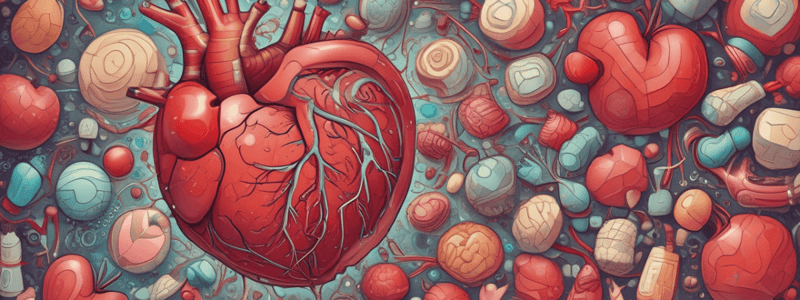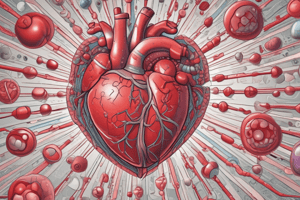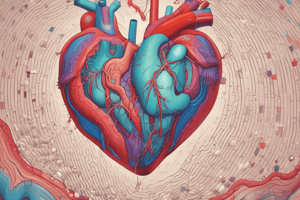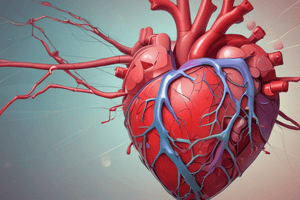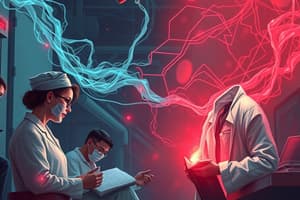Podcast
Questions and Answers
What is the primary function of LDL in the body?
What is the primary function of LDL in the body?
- To produce bile acids in the liver
- To remove excess cholesterol from the bloodstream
- To inhibit the manufacture of cholesterol
- To transport cholesterol from the liver to peripheral tissues (correct)
What is the mechanism of action of antihyperlipidemic drugs?
What is the mechanism of action of antihyperlipidemic drugs?
- Enhancing the excretion of cholesterol
- Increasing the loss of bile acids (correct)
- Reducing the absorption of dietary fats
- Inhibiting the breakdown of cholesterol
What is a potential adverse reaction of antihyperlipidemic drugs?
What is a potential adverse reaction of antihyperlipidemic drugs?
- Diarrhea
- Constipation (correct)
- Nausea
- Fatigue
What is the term for the formation of a clot in a blood vessel?
What is the term for the formation of a clot in a blood vessel?
What is the term for a clot that breaks loose and travels through the bloodstream?
What is the term for a clot that breaks loose and travels through the bloodstream?
What is the benefit of reducing LDL cholesterol levels?
What is the benefit of reducing LDL cholesterol levels?
What is the term for 'good' cholesterol?
What is the term for 'good' cholesterol?
What is a potential complication of a thrombus breaking loose and traveling to a smaller vessel?
What is a potential complication of a thrombus breaking loose and traveling to a smaller vessel?
Which of the following is a primary function of the cardiovascular system?
Which of the following is a primary function of the cardiovascular system?
What is the primary mechanism of action of Peripheral Vasodilating drugs?
What is the primary mechanism of action of Peripheral Vasodilating drugs?
Which of the following is a class of Anti-Hypertensive drugs that works by blocking the action of angiotensin-converting enzyme?
Which of the following is a class of Anti-Hypertensive drugs that works by blocking the action of angiotensin-converting enzyme?
What is the primary goal of Hyperlipidemia treatment?
What is the primary goal of Hyperlipidemia treatment?
Which of the following is NOT a treatment option for Hyperlipidemia?
Which of the following is NOT a treatment option for Hyperlipidemia?
What is the primary role of lipids in the body?
What is the primary role of lipids in the body?
Which of the following is a characteristic of Hyperlipidemia?
Which of the following is a characteristic of Hyperlipidemia?
What is the primary mechanism of action of Antihypertensive drugs?
What is the primary mechanism of action of Antihypertensive drugs?
What is the primary mechanism of action of cardiotonics in treating heart failure?
What is the primary mechanism of action of cardiotonics in treating heart failure?
Which of the following is a common adverse reaction to antiarrhythmic drugs?
Which of the following is a common adverse reaction to antiarrhythmic drugs?
What is the primary cause of atherosclerosis?
What is the primary cause of atherosclerosis?
Which of the following drugs is used to treat cardiac arrhythmias?
Which of the following drugs is used to treat cardiac arrhythmias?
What is the primary goal of treating cardiac arrhythmias?
What is the primary goal of treating cardiac arrhythmias?
Which of the following conditions is characterized by a disturbed or irregular heart rate or rhythm?
Which of the following conditions is characterized by a disturbed or irregular heart rate or rhythm?
What is the primary effect of peripheral vasodilators?
What is the primary effect of peripheral vasodilators?
Which of the following is a common use of cardiotonics?
Which of the following is a common use of cardiotonics?
What is the primary mechanism of action of peripheral vasodilators?
What is the primary mechanism of action of peripheral vasodilators?
What is the normal range for systolic blood pressure?
What is the normal range for systolic blood pressure?
What is the primary goal of antihypertensive drugs?
What is the primary goal of antihypertensive drugs?
Which type of antihypertensive drug increases sodium excretion from the body?
Which type of antihypertensive drug increases sodium excretion from the body?
What is a potential adverse reaction of peripheral vasodilators?
What is a potential adverse reaction of peripheral vasodilators?
What is the primary consequence of unmanaged hypertension?
What is the primary consequence of unmanaged hypertension?
Which class of antihypertensive drugs works by inhibiting the action of angiotensin-converting enzyme?
Which class of antihypertensive drugs works by inhibiting the action of angiotensin-converting enzyme?
What is the primary goal of treating hypertension?
What is the primary goal of treating hypertension?
What is the primary mechanism of action of anticoagulant drugs like Warfarin and Heparin?
What is the primary mechanism of action of anticoagulant drugs like Warfarin and Heparin?
What is the primary use of thrombolytic drugs?
What is the primary use of thrombolytic drugs?
What is a common adverse reaction of anticoagulant drugs?
What is a common adverse reaction of anticoagulant drugs?
What is the name of the oral anticoagulant mentioned in the text?
What is the name of the oral anticoagulant mentioned in the text?
What is the primary condition that thrombolytic drugs are effective in treating?
What is the primary condition that thrombolytic drugs are effective in treating?
What is the name of the injectable anticoagulant mentioned in the text?
What is the name of the injectable anticoagulant mentioned in the text?
What is another use of anticoagulant drugs besides preventing and treating thrombotic events?
What is another use of anticoagulant drugs besides preventing and treating thrombotic events?
What is a common side effect of anticoagulant drugs besides bleeding?
What is a common side effect of anticoagulant drugs besides bleeding?
What is the mechanism of action of Tricyclic Antidepressants?
What is the mechanism of action of Tricyclic Antidepressants?
What class of antidepressants inhibit the uptake of serotonin into the same neuron?
What class of antidepressants inhibit the uptake of serotonin into the same neuron?
What is the mechanism of action of some antidepressants that block the reuptake of endogenous neurotransmitters?
What is the mechanism of action of some antidepressants that block the reuptake of endogenous neurotransmitters?
Which class of antidepressants inhibit the enzymes that can destroy neurotransmitters?
Which class of antidepressants inhibit the enzymes that can destroy neurotransmitters?
How many types of antidepressants are mentioned in the text?
How many types of antidepressants are mentioned in the text?
What is the primary mechanism of action of Monoamine Oxidase Inhibitors?
What is the primary mechanism of action of Monoamine Oxidase Inhibitors?
Which of the following conditions is a therapeutic use of Monoamine Oxidase Inhibitors?
Which of the following conditions is a therapeutic use of Monoamine Oxidase Inhibitors?
What is a common adverse reaction of Monoamine Oxidase Inhibitors?
What is a common adverse reaction of Monoamine Oxidase Inhibitors?
Which class of antidepressants is used to manage Depression?
Which class of antidepressants is used to manage Depression?
What is the result of Monoamine Oxidase Inhibitors' mechanism of action on CNS stimulation?
What is the result of Monoamine Oxidase Inhibitors' mechanism of action on CNS stimulation?
Which neurotransmitter is involved in movement, attention, and emotion?
Which neurotransmitter is involved in movement, attention, and emotion?
What is the consequence of a serotonin deficiency?
What is the consequence of a serotonin deficiency?
Which neurotransmitter is involved in alertness?
Which neurotransmitter is involved in alertness?
What is the consequence of a dopamine deficiency?
What is the consequence of a dopamine deficiency?
Which of the following neurotransmitters is involved in mood regulation?
Which of the following neurotransmitters is involved in mood regulation?
What is the primary effect of non-benzodiazepine on nerve impulse transmission?
What is the primary effect of non-benzodiazepine on nerve impulse transmission?
What is the main difference between barbiturates and benzodiazepine when given together?
What is the main difference between barbiturates and benzodiazepine when given together?
What is another use of non-benzodiazepine besides treating anxiety disorders?
What is another use of non-benzodiazepine besides treating anxiety disorders?
What is the primary mechanism of action of non-benzodiazepine?
What is the primary mechanism of action of non-benzodiazepine?
What is a common adverse reaction of non-benzodiazepine?
What is a common adverse reaction of non-benzodiazepine?
What is the primary function of neurotransmitters in the nervous system?
What is the primary function of neurotransmitters in the nervous system?
What is the mechanism of action of agonist drugs on neurotransmitters?
What is the mechanism of action of agonist drugs on neurotransmitters?
What is the effect of CNS stimulants on the respiratory center in carotid arteries?
What is the effect of CNS stimulants on the respiratory center in carotid arteries?
What is the primary use of CNS stimulants?
What is the primary use of CNS stimulants?
What is the mechanism of action of reuptake inhibitor drugs on neurotransmitters?
What is the mechanism of action of reuptake inhibitor drugs on neurotransmitters?
What is the primary therapeutic use of barbiturates?
What is the primary therapeutic use of barbiturates?
What is a common adverse reaction of barbiturates?
What is a common adverse reaction of barbiturates?
What is the mechanism of action of benzodiazepines?
What is the mechanism of action of benzodiazepines?
What is the therapeutic use of anti-anxiety drugs?
What is the therapeutic use of anti-anxiety drugs?
What is the effect of barbiturates on the CNS?
What is the effect of barbiturates on the CNS?
What is the difference between benzodiazepines and non-benzodiazepines?
What is the difference between benzodiazepines and non-benzodiazepines?
What is the effect of barbiturates on respiration?
What is the effect of barbiturates on respiration?
What is the therapeutic use of barbiturates in surgery?
What is the therapeutic use of barbiturates in surgery?
What is the effect of long-term use of barbiturates?
What is the effect of long-term use of barbiturates?
What is the adverse reaction of barbiturates on the cardiovascular system?
What is the adverse reaction of barbiturates on the cardiovascular system?
What is the primary effect of sedatives on a patient?
What is the primary effect of sedatives on a patient?
What is the mechanism of action of barbiturates?
What is the mechanism of action of barbiturates?
What is the duration of action of ultrashort-acting barbiturates?
What is the duration of action of ultrashort-acting barbiturates?
What is the effect of GABA on impulse transmission?
What is the effect of GABA on impulse transmission?
What is the primary effect of hypnotics on a patient?
What is the primary effect of hypnotics on a patient?
What is the mechanism of action of Monoamine Oxidase Inhibitors (MAOIs) on neurotransmitters?
What is the mechanism of action of Monoamine Oxidase Inhibitors (MAOIs) on neurotransmitters?
What is the result of Monoamine Oxidase Inhibitors' mechanism of action on CNS stimulation?
What is the result of Monoamine Oxidase Inhibitors' mechanism of action on CNS stimulation?
What is a therapeutic use of Monoamine Oxidase Inhibitors?
What is a therapeutic use of Monoamine Oxidase Inhibitors?
What is a common adverse reaction of Monoamine Oxidase Inhibitors?
What is a common adverse reaction of Monoamine Oxidase Inhibitors?
What is the difference between the therapeutic uses of Monoamine Oxidase Inhibitors and barbiturates?
What is the difference between the therapeutic uses of Monoamine Oxidase Inhibitors and barbiturates?
What is the primary mechanism of action of Dopaminergic drugs?
What is the primary mechanism of action of Dopaminergic drugs?
What is the primary therapeutic use of Anesthetic drugs?
What is the primary therapeutic use of Anesthetic drugs?
What is the primary mechanism of action of Anticholinergic drugs?
What is the primary mechanism of action of Anticholinergic drugs?
What is the primary therapeutic use of Anti-parkinsonism drugs?
What is the primary therapeutic use of Anti-parkinsonism drugs?
What is the primary effect of Anesthetic drugs on nerve impulse transmission?
What is the primary effect of Anesthetic drugs on nerve impulse transmission?
What is the consequence of the chloride channel remaining open for a very long time?
What is the consequence of the chloride channel remaining open for a very long time?
What is the effect of non-benzodiazepines on the brain?
What is the effect of non-benzodiazepines on the brain?
What is a therapeutic use of benzodiazepines?
What is a therapeutic use of benzodiazepines?
What is the difference between benzodiazepines and barbiturates when given together?
What is the difference between benzodiazepines and barbiturates when given together?
What is the primary mechanism of action of non-benzodiazepines?
What is the primary mechanism of action of non-benzodiazepines?
What is the primary mechanism of action of benzodiazepines?
What is the primary mechanism of action of benzodiazepines?
What is the effect of GABA on impulse transmission?
What is the effect of GABA on impulse transmission?
How do barbiturates and benzodiazepines compare in terms of mechanism of action?
How do barbiturates and benzodiazepines compare in terms of mechanism of action?
What is a therapeutic use of non-benzodiazepines?
What is a therapeutic use of non-benzodiazepines?
What is a therapeutic use of barbiturates?
What is a therapeutic use of barbiturates?
What is the effect of barbiturates on the chloride channel?
What is the effect of barbiturates on the chloride channel?
What is the primary therapeutic use of hypnotics?
What is the primary therapeutic use of hypnotics?
How do barbiturates facilitate the action of GABA?
How do barbiturates facilitate the action of GABA?
What is the primary difference between barbiturates and non-benzodiazepines?
What is the primary difference between barbiturates and non-benzodiazepines?
Which of the following is a common therapeutic use of benzodiazepines?
Which of the following is a common therapeutic use of benzodiazepines?
What is the primary mechanism of action of Tricyclic Antidepressants?
What is the primary mechanism of action of Tricyclic Antidepressants?
What is the primary mechanism of action of Selective Serotonin Reuptake Inhibitors?
What is the primary mechanism of action of Selective Serotonin Reuptake Inhibitors?
What is the primary effect of some antidepressants that block the reuptake of endogenous neurotransmitters?
What is the primary effect of some antidepressants that block the reuptake of endogenous neurotransmitters?
What is the primary mechanism of action of Monoamine Oxidase Inhibitors on neurotransmitters?
What is the primary mechanism of action of Monoamine Oxidase Inhibitors on neurotransmitters?
What is the primary therapeutic use of antidepressants that inhibit the uptake of serotonin into the same neuron?
What is the primary therapeutic use of antidepressants that inhibit the uptake of serotonin into the same neuron?
What is the primary mechanism of action of antiepileptic drugs?
What is the primary mechanism of action of antiepileptic drugs?
What is the primary therapeutic use of antiepileptic drugs?
What is the primary therapeutic use of antiepileptic drugs?
What is the primary characteristic of epilepsy?
What is the primary characteristic of epilepsy?
What is the primary cause of Parkinson's disease?
What is the primary cause of Parkinson's disease?
What is the primary symptom of Parkinson's disease?
What is the primary symptom of Parkinson's disease?
What is the primary goal of treating Parkinson's disease?
What is the primary goal of treating Parkinson's disease?
What is the primary effect of antiepileptic drugs on neurons?
What is the primary effect of antiepileptic drugs on neurons?
What is the primary difference between epilepsy and Parkinson's disease?
What is the primary difference between epilepsy and Parkinson's disease?
What is the primary therapeutic use of anti-parkinsonism drugs?
What is the primary therapeutic use of anti-parkinsonism drugs?
What is the primary characteristic of a seizure?
What is the primary characteristic of a seizure?
What is the primary mechanism of action of Monoamine Oxidase Inhibitors (MAOIs) on neurotransmitters?
What is the primary mechanism of action of Monoamine Oxidase Inhibitors (MAOIs) on neurotransmitters?
What is the primary therapeutic use of Monoamine Oxidase Inhibitors (MAOIs)?
What is the primary therapeutic use of Monoamine Oxidase Inhibitors (MAOIs)?
What is a common adverse reaction of Monoamine Oxidase Inhibitors (MAOIs)?
What is a common adverse reaction of Monoamine Oxidase Inhibitors (MAOIs)?
What is the effect of GABA on impulse transmission?
What is the effect of GABA on impulse transmission?
How do Monoamine Oxidase Inhibitors (MAOIs) compare to non-benzodiazepines?
How do Monoamine Oxidase Inhibitors (MAOIs) compare to non-benzodiazepines?
What is the primary mechanism of action of Dopaminergic drugs?
What is the primary mechanism of action of Dopaminergic drugs?
What is the primary effect of anesthetic drugs on nerve impulse transmission?
What is the primary effect of anesthetic drugs on nerve impulse transmission?
Which type of anesthetic is used to induce a loss of sensation in a specific area of the body?
Which type of anesthetic is used to induce a loss of sensation in a specific area of the body?
What is the primary therapeutic use of Anti-parkinsonism drugs?
What is the primary therapeutic use of Anti-parkinsonism drugs?
What is the primary mechanism of action of Anticholinergic drugs?
What is the primary mechanism of action of Anticholinergic drugs?
What is the effect of chloride ions entering the cell when barbiturates and benzodiazepines are given together?
What is the effect of chloride ions entering the cell when barbiturates and benzodiazepines are given together?
What is the mechanism of action of non-benzodiazepines?
What is the mechanism of action of non-benzodiazepines?
What is the primary therapeutic use of benzodiazepines?
What is the primary therapeutic use of benzodiazepines?
How do barbiturates and non-benzodiazepines differ?
How do barbiturates and non-benzodiazepines differ?
What is the effect of GABA on nerve impulse transmission?
What is the effect of GABA on nerve impulse transmission?
What is the effect of barbiturates on the chloride channel?
What is the effect of barbiturates on the chloride channel?
What is the primary effect of barbiturates on the chloride channel?
What is the primary effect of barbiturates on the chloride channel?
How do benzodiazepines and barbiturates compare in terms of their mechanism of action on GABA?
How do benzodiazepines and barbiturates compare in terms of their mechanism of action on GABA?
What is the primary therapeutic use of sedatives?
What is the primary therapeutic use of sedatives?
How do barbiturates facilitate the action of GABA?
How do barbiturates facilitate the action of GABA?
What is a therapeutic use of non-benzodiazepines?
What is a therapeutic use of non-benzodiazepines?
What is the primary difference between benzodiazepines and non-benzodiazepines?
What is the primary difference between benzodiazepines and non-benzodiazepines?
How do barbiturates facilitate the action of GABA?
How do barbiturates facilitate the action of GABA?
What is the primary mechanism of action of anti-anxiety drugs?
What is the primary mechanism of action of anti-anxiety drugs?
What is the primary therapeutic use of hypnotics?
What is the primary therapeutic use of hypnotics?
What is the primary mechanism of action of Tricyclic Antidepressants (TCAs)?
What is the primary mechanism of action of Tricyclic Antidepressants (TCAs)?
What is the effect of GABA on impulse transmission?
What is the effect of GABA on impulse transmission?
How do barbiturates compare to non-benzodiazepines?
How do barbiturates compare to non-benzodiazepines?
What is a therapeutic use of Selective Serotonin Reuptake Inhibitors (SSRIs)?
What is a therapeutic use of Selective Serotonin Reuptake Inhibitors (SSRIs)?
What is a common effect of antidepressants on the CNS?
What is a common effect of antidepressants on the CNS?
What is the primary mechanism of action of antiepileptic drugs?
What is the primary mechanism of action of antiepileptic drugs?
What is the effect of GABA on impulse transmission?
What is the effect of GABA on impulse transmission?
What is the main difference between barbiturates and non-benzodiazepines?
What is the main difference between barbiturates and non-benzodiazepines?
What is the primary therapeutic use of non-benzodiazepines?
What is the primary therapeutic use of non-benzodiazepines?
What is the mechanism of action of antiepileptic drugs in relieving seizures?
What is the mechanism of action of antiepileptic drugs in relieving seizures?
What is the primary therapeutic use of antiepileptic drugs?
What is the primary therapeutic use of antiepileptic drugs?
What is the effect of barbiturates on the chloride channel?
What is the effect of barbiturates on the chloride channel?
What is the difference between barbiturates and non-benzodiazepines in terms of their effect on the chloride channel?
What is the difference between barbiturates and non-benzodiazepines in terms of their effect on the chloride channel?
What is the primary mechanism of action of non-benzodiazepines?
What is the primary mechanism of action of non-benzodiazepines?
What is the therapeutic use of antiepileptic drugs in patients with epilepsy?
What is the therapeutic use of antiepileptic drugs in patients with epilepsy?
Flashcards are hidden until you start studying
Study Notes
Cardiovascular System
- The cardiovascular system consists of the heart, blood vessels, and blood.
- Function of cardiovascular system: supply oxygen and nutrients to body tissues, remove toxic waste products, regulate body temperature.
Hyperlipidemia
- Hyperlipidemia: increased blood lipids (cholesterol or triglycerides) carried by lipid-containing proteins (lipoproteins).
- Low-density lipoprotein (LDL): "bad cholesterol", transports cholesterol to cells and releases excess cholesterol into blood, causing hyperlipidemia.
- High-density lipoprotein (HDL): "good cholesterol".
- Anti-hyperlipidemic drugs: increase loss of bile acids, inhibit cholesterol manufacture, and cause cholesterol breakdown.
- Uses: reduce LDL, total cholesterol, and triglycerides.
- Adverse reactions: constipation, hemorrhoids, vitamin A and D deficiencies, abdominal pain, gallbladder stones.
Thrombosis and Embolism
- Thrombosis: formation of a clot (thrombus) in a blood vessel.
- Embolism: when a thrombus detaches from the blood vessel wall and enters a smaller vessel.
- Examples: deep vein thrombosis, pulmonary embolism, myocardial infarction.
Cardiovascular Drugs
- Cardiotonics: used to treat heart failure, increase heart muscle contraction.
- Antiarrhythmic drugs: restore normal cardiac function, prevent arrhythmias.
- Peripheral vasodilators: used to treat atherosclerosis, dilate blood vessels.
- Antihypertensive drugs: reduce blood pressure.
Anticoagulants and Thrombolytic Drugs
- Anticoagulants: prevent thrombosis, interact with blood clotting mechanism.
- Thrombolytic drugs: dissolve blood clots, used to treat acute myocardial infarction, deep vein thrombosis, and pulmonary embolism.
Neurotransmitters and Nerve Impulse Transmission
- Neurotransmitters: dopamine, serotonin, norepinephrine, involved in movement, mood, hunger, sleep, and attention.
- Deficiency in neurotransmitters can cause Parkinson's disease, depression.
Antidepressant Drugs
- Used to manage depression, relieve pain, prevent migraines, and treat premenstrual syndrome.
- MOA: block the reuptake of neurotransmitters, increase CNS stimulation.
- Examples: Tricyclic antidepressants, Selective Serotonin Reuptake Inhibitors (SSRIs), Monoamine Oxidase Inhibitors (MAOIs).
Sedatives and Hypnotics
- Sedatives: produce a relaxing and calming effect, do not produce sleep.
- Hypnotics: induce sleep, allow patients to fall asleep and stay asleep.
- MOA: facilitate the action of GABA, increase the length of time chloride channels remain open.
- Examples: Barbiturates, Benzodiazepines.
Anti-Anxiety Drugs
- Used to treat anxiety disorders, produce a calming effect.
- MOA: increase or help the effects of GABA, inhibit impulse transmission, cause CNS depression.
- Examples: Benzodiazepines, Non-benzodiazepines.
Antiparkinsonism Drugs
- Used to treat signs and symptoms of Parkinsonism.
- Dopaminergic drugs: increase dopamine production, promote activation of dopamine receptors.
- Anticholinergic drugs: decrease acetylcholine production, prevent activation of acetylcholine receptors.
Anesthesia and Anesthetic Drugs
- Anesthesia: loss of feeling or sensation.
- Anesthetic drugs: temporarily inhibit nerve impulse transmission, especially pain impulse, to the brain.
- Types of anesthesia: local, topical, local infiltration, general, regional anesthesia.### Sedatives and Hypnotics
- Sedatives: drugs that produce a relaxing and calming effect, can make patients drowsy but do not produce sleep
- Hypnotics: drugs that induce sleep, allow patients to fall asleep and stay asleep
Mechanism of Action of Benzodiazepines
- Increase the effects of GABA (inhibitory neurotransmitter)
- Chloride channel opened for a long period of time, inhibiting impulse transmission and causing CNS depression
Barbiturates
- MOA: facilitate the action of GABA (inhibitory neurotransmitter), increasing the length of time the chloride channel remains open
- High number of chloride ions inhibit impulse transmission, causing CNS depression
- Effects: CNS depression, mild sedation, hypnosis (sleep), deep coma, and respiratory depression
- Effects diminish after approximately 2 weeks
- Therapeutic uses: treat insomnia (sleeping disorder), given the night before the operation to prepare the patient for surgery
- Adverse reactions: CNS depression, sedation, and hallucination; respiratory depression; gastrointestinal nausea and vomiting; cardiovascular bradycardia and hypotension; hypersensitivity rash and fever
Anti-anxiety Drugs (Tranquilizers)
- Anxiety: feeling of apprehension, worry, or uneasiness that may not be based on reality
- Excess anxiety interferes with day-to-day functioning and can cause undue stress
- Drug used to treat anxiety: anti-anxiety drugs (benzodiazepines and non-benzodiazepines)
Anti-depressant Drugs
- Depression: most common psychiatric disorder, characterized by feelings of intense sadness, helplessness, worthlessness, and impaired functioning
- There are 4 types of anti-depressants: tricyclic antidepressants (TCAs), monoamine oxidase inhibitors (MAOIs), selective serotonin reuptake inhibitors (SSRIs), and miscellaneous unrelated drugs
- MOA: some antidepressants block the reuptake of endogenous neurotransmitters, causing CNS stimulation and relief from depression
- Examples of antidepressants: tricyclic antidepressants (TCAs) inhibit uptake of norepinephrine and serotonin into the same neuron; selective serotonin reuptake inhibitors (SSRIs) inhibit the uptake of serotonin into the same neuron
- Adverse reactions: excessive CNS stimulation, headache, dizziness, insomnia, hyperactivity, excitements, and nervousness
Epilepsy
- Epilepsy: disorder of CNS in which patients may have convulsion or seizures
- Seizure: periodic attack of disturbed cerebral function (repeated coordinated but inappropriate movements)
- Epilepsy is defined as a permanent seizure disorder
- Antiepileptic drugs: MOA reduces the excitability of neurons (nerve cells) in the brain, resulting in reduced seizure
- Uses: to relieve seizure
- Adverse reactions: nausea and vomiting, constipation, hepatotoxicity
Parkinson's Disease
- Parkinsonism: neurological disorder of muscle movement, caused by deficiency of dopamine and excess of acetylcholine within the CNS
- Parkinson disease affects the part of the brain that controls muscle movements
- Symptoms: tremor, muscular rigidity, and difficulty in walking
- No cure for Parkinson disease, but symptoms can be relieved using anti-parkinsonism drugs
- MOA: increase the production of dopamine, promote the activation of dopamine receptors, decrease the production of acetylcholine, and prevent the activation of acetylcholine receptors
Studying That Suits You
Use AI to generate personalized quizzes and flashcards to suit your learning preferences.
